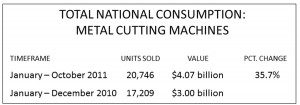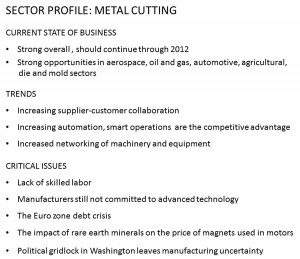2012 State of the Industry: Metal Cutting Machine Tools
Forecast: Watch for increasing supplier-customer collaboration on increasing automation, smart operations, and networking of machinery and equipment in the aerospace, oil and gas, automotive, agricultural, die and mold sectors.
Posted: January 10, 2012
Forecast: Watch for increasing supplier-customer collaboration on increasing automation, smart operations, and networking of machinery and equipment in the aerospace, oil and gas, automotive, agricultural, die and mold sectors.
 Brian Papke
Brian Papke
President, Mazak Corporation
Manufacturer of CNC turning centers, horizontal and vertical machining centers, multi-tasking machining centers, turnkey cells and automated systems for the precision machining of metal parts.
CURRENT STATE OF BUSINESS
Current manufacturing is definitely experiencing some positive momentum, which I believe will continue through 2012. Industrial production statistics will continue to remain favorable, as will equipment utilization levels that have been on the rise for all industries.
When considering specific industry market segments, I see auto industry activity continuing to increase, as well as the truck and construction equipment industries. And due to foreign demand, the commercial aircraft industry will also be busy in 2012, driven by the start of shipping the Boeing 787 Dreamliners and an already existing high backlog.
I predict favorable conditions for component manufacturers supplying aircraft parts. We will also see considerable 2012 activity in the oil and gas, as well as other energy industry segments, both domestically and in foreign countries. The extraction of huge natural gas deposits in North America will also spur much growth in this industry.
MAJOR TRENDS
In 2012, I see the success of American manufacturers continuing to depend on more than just machine tools. New technology is critical, but that technology must be partnered with strong commitments to customer success from those supplying the technology. The key is long-term business partnerships where suppliers and customers work together to generate creative ideas for improving productivity, efficiency, equipment utilization, and overall manufacturing safety.
In addition to being critical to the success of today’s and tomorrow’s manufacturers, these topics will continue to strongly influence the design of future machine tools. And if suppliers themselves wish to succeed, they must take the responsibility of facilitating such partnerships. As we have in the past and will continue to do so, we will make further investments in our Kentucky manufacturing facility and in our regional technology centers through 2012. We will continue to create new technology centers throughout the world, and through these new facilities and our existing technology centers, will continue to partner with customers to develop true solutions and competitive processes tailored to their specific manufacturing requirements.
As far as manufacturing technology is concerned, we will see more machines that offer increased ergonomic and environmental performance and new systems designed to ramp up machine tool productivity, performance, reliability, and durability. We will continue to expand and build upon our multi-tasking machine technology, which has advanced to the point where nearly any part imaginable can be machined to completion in a single set up. These optimized multitasking solutions will continue to allow for machining simple to complex geometries on small, large and heavy parts within prototyping to high-volume production environments in basic job shops to high-tech, manufacturing cells.
All shops can benefit from multi-tasking technology, but it must be tailored to meet each shop’s specific manufacturing needs. This is why we developed our five levels of multi-tasking that allow our customers, no matter what their levels of manufacturing might be, to choose the proper solution that will truly increase their productivity.
We will also keep our focus on supporting a broad spectrum of automation solutions for our customers as they strive to reduce their dependence on skilled manpower and increase levels of machine utilization. Bar feeders, pallet changers, robots and automation will continue to simplify the attainment of 24/7 production and provide greater returns on investment.
Another growing technological trend is the MTConnect standard. Manufacturers need more than just machine tools, so look for this standard to become more accepted throughout the industry during the coming year and beyond as companies move toward offering complete manufacturing solutions that can entail automation, tooling, workholding, software and more.
MTConnect is critical to improving machine utilization, and we are making it easier for our customers to implement the standard. We are building machines that are compliant with MTConnect, and we offer moderately priced MTConnect adaptors applicable to just about all of our newer existing equipment in the field. Additionally, MTConnect is a standard price-list item for our customers, and there are no engineering charges or technicians’ fees, because adding the capability happens all within a machine’s CNC.
We will continue to take an aggressive approach in supporting MTConnect, and our customers have already commended us for doing so. They give us very high marks for taking a leadership role with the standard and for focusing all our efforts on getting them the most utilization out of their machine tools.
CRITICAL ISSUES
Probably the most critical issues the industry faces in the coming year are the shortage of skilled labor and the widely held misconception that manufacturing is a dying industry in the United States. As a nation, over time, we have done a disservice to the future of U.S. manufacturing by allowing ourselves to be convinced that all manufacturing has moved offshore, or even that our nation is no longer an advantageous place to produce goods. U.S. manufacturing is constantly being underrated and under-supported, and careers within the industry thought of as dirty, dangerous and undesirable, especially among the youth of our country.
Plain and simple: U.S. manufacturing must be made a national priority, as it once was long ago. We need to set our political agendas aside and implement realistic programs and strategies to promote and continue to grow U.S. manufacturing. We need to create a government framework that is less intrusive and more supportive of U.S. manufacturing, a framework that would center on increasing skilled labor and on creating more favorable government regulations concerning unionization, the EPA and exports. And within this framework, if certain tax laws are effective, policy makers should keep them in place as meaningful economic tools to help bolster manufacturing.
But most importantly, we need to aggressively market the fact that careers in manufacturing are both lucrative and respectable. More funding must be allocated to vocational schools and community college technical programs. And the U.S. government must champion the cause by promoting all the opportunities manufacturing has to offer.
We maintain our own long-established apprentice program and encourage all U.S. manufacturers to do the same. We actively engage in strategies to help solve the skilled labor problem in our area and across North America and will continue to work closely with training institutions, technical colleges and vocational programs, joint manufacturing and technology centers that offer training programs to employees and surrounding communities.
PERSONAL INSIGHTS
Favorable conditions will continue into 2012 as more foreign companies will be considering the option of manufacturing in the U.S., and those foreign companies already established here will most likely be expanding their production operations. In 2012, the U.S. will be the place to manufacture. Exporting is on the rise, and conditions are indicating that it’s no longer the most cost-effective or efficient to have work done offshore. But most importantly, advanced manufacturing equipment technology will continue to generate the highest levels of productivity ever.
The stage is set for success. But be advised, achieving it will take more than just favorable industry conditions. There must be, on the part of manufacturing companies, a commitment to continuously re-evaluate and invest in manufacturing operations to improve processes and increase competitiveness. Without such commitment, many opportunities resulting from current positive business conditions will be missed.
Mazak Corporation, 8025 Production Drive, P.O. Box 970, Florence, KY 41042, 859-342-1700, Fax: 859-342-1865, www.mazakusa.com.
 Glynn Fletcher
Glynn Fletcher
President Americas, GF AgieCharmilles
Manufacturer of electrical discharge machines, high-speed and high performance milling machines, laser ablation machines, clamping and palletization systems, services, spare parts and expendable parts, consumables and automation solutions for the tool and moldmaking industry and for manufacturers of precision components.
CURRENT STATE OF BUSINESS
For the first time in several years, U.S. manufacturing has outperformed the rest of the economy, and I see that strong performance continuing through 2012. One market sector that will present a significant amount of opportunity in 2012 is the aerospace industry. The upswing can be attributed to Boeing’s estimates that commercial airline companies will need 33,500 new airplanes by the year 2030, a need valued at about $4 trillion.
A large majority of those airplanes will be built in North America, which presents a tremendous amount of opportunity for U.S. manufacturing. And those opportunities are further expanded when one also takes into account the defense sector of the aerospace industry, a sector that the U.S. spends as much money on as the rest of the world combined does. Such activity in the aerospace industry also translates into huge business prospects for the machine tool industry going forward in 2012, especially in regards to high-speed milling, five-axis machining and automation technology.
MAJOR TRENDS
A trend I see in 2012 is that significantly more work once outsourced to China will return to the U.S., mainly because China is no longer the “default location” for low-cost plants to supply the U.S. market. Chinese wage inflation running at 16 percent a year for a decade has closed much of the cost gap between the two countries. The gap in “productivity-adjusted wages” is expected to narrow from 22 percent of U.S. levels in 2005 to 43 percent (61 percent for the southern U.S.) by 2015.
Add in shipping costs, reliability woes and technology piracy, and the case for manufacturing in the U.S. grows even stronger. In fact, we are currently seeing a surprising amount of the production of computers, electrical equipment, machinery, automobiles and engine/motor parts, plastics and rubber, fabricated metals and even furniture making its way back into our country.
For our U.S. manufacturing customers, advanced technology is their competitive advantage. As a result, the criterion for machine tool application and selection has changed. Simply adding more spindles to improve productivity and capacity is no longer the most effective approach. Instead, companies are seeking highly advanced manufacturing systems that will differentiate them from the competition and significantly improve productivity.
As a machine tool builder our plan has been, and will continue to be, developing complete high-tech manufacturing systems that deliver increased speed, efficiency and precision and that allow our customers to achieve more with less. But just as critical, we will continue to pair these systems with unparalleled service, application support and training so that our customers can truly optimize their part processing operations and further leverage their competitive advantages.
CRITICAL ISSUES
One critical issue is that many manufacturing companies still fail to fully commit when it comes to incorporating sophisticated, high-tech equipment as well as new processes such as five-axis machining, high-speed milling or automation. Most often than not this is simply due to the uneasiness of venturing too far beyond one’s comfort zone.
As a result, these companies, unfortunately, often fall short and end up just “dabbling” with the advanced technology. Such half-hearted approaches are a sure recipe for frustration and, perhaps, failure. Incorporating five-axis high-speed milling, automation or any other advanced technology takes an all-out commitment to evolve beyond the safe and known and to start thinking and acting differently.
















